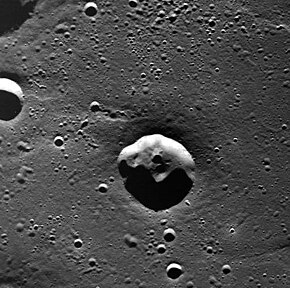
An impact crater is a depression in the surface of a solid astronomical body formed by the hypervelocity impact of a smaller object. In contrast to volcanic craters, which result from explosion or internal collapse, impact craters typically have raised rims and floors that are lower in elevation than the surrounding terrain. Impact craters are typically circular, though they can be elliptical in shape or even irregular due to events such as landslides. Impact craters range in size from microscopic craters seen on lunar rocks returned by the Apollo Program to simple bowl-shaped depressions and vast, complex, multi-ringed impact basins. Meteor Crater is a well-known example of a small impact crater on Earth.

Sofonisba Anguissola, also known as Sophonisba Angussola or Sophonisba Anguisciola, was an Italian Renaissance painter born in Cremona to a relatively poor noble family. She received a well-rounded education that included the fine arts, and her apprenticeship with local painters set a precedent for women to be accepted as students of art. As a young woman, Anguissola traveled to Rome where she was introduced to Michelangelo, who immediately recognized her talent, and to Milan, where she painted the Duke of Alba. The Spanish queen, Elizabeth of Valois, was a keen amateur painter and in 1559 Anguissola was recruited to go to Madrid as her tutor, with the rank of lady-in-waiting. She later became an official court painter to the king, Philip II, and adapted her style to the more formal requirements of official portraits for the Spanish court. After the queen's death, Philip helped arrange an aristocratic marriage for her. She moved to Sicily, and later Pisa and Genoa, where she continued to practice as a leading portrait painter.
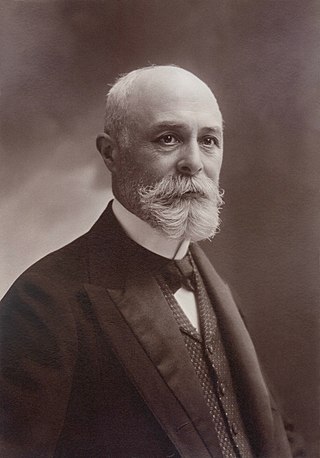
Antoine Henri Becquerel was a French engineer, physicist, Nobel laureate, and the first person to discover radioactivity. For work in this field he, along with Marie Skłodowska-Curie and Pierre Curie, received the 1903 Nobel Prize in Physics. The SI unit for radioactivity, the becquerel (Bq), is named after him.

Anyte of Tegea was a Hellenistic poet from Tegea in Arcadia. Little is known of her life, but twenty-four epigrams attributed to her are preserved in the Greek Anthology, and one is quoted by Julius Pollux; nineteen of these are generally accepted as authentic. She introduced rural themes to the genre, which became a standard theme in Hellenistic epigrams. She is one of the nine outstanding ancient women poets listed by Antipater of Thessalonica in the Palatine Anthology. Her pastoral poetry may have influenced Theocritus, and her works were adapted by several later poets, including Ovid.

Elisabeth of France, or Elisabeth of Valois, was Queen of Spain as the third wife of Philip II of Spain. She was the eldest daughter of Henry II of France and Catherine de' Medici.
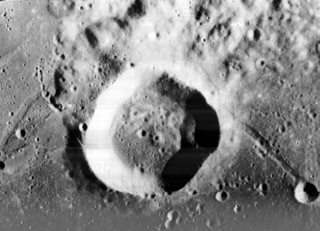
Lunar craters are impact craters on Earth's Moon. The Moon's surface has many craters, all of which were formed by impacts. The International Astronomical Union currently recognizes 9,137 craters, of which 1,675 have been dated.

Sholem Aleichem is a crater on Mercury, named after the Yiddish writer Sholem Aleichem. The inter-crater plain deposits have been deformed by linear ridges.

Matisse is an impact crater on the southern hemisphere of Mercury. Matisse takes its name from the French artist Henri Matisse, and it was named by the IAU in 1976.

Tikhonravov is a large, eroded crater in the Arabia quadrangle of Mars. It is 344 kilometres (214 mi) in diameter and was named after Mikhail Tikhonravov, a Russian rocket scientist. Tikhonravov is believed to have once held a giant lake that drained into the 4,500-kilometre-long (2,800 mi) Naktong-Scamander-Mamers lake-chain system. An inflow and outflow channel has been identified. Many craters once contained lakes.

Berkel is a crater on the planet Mercury. Its name was approved by the IAU on July 9, 2009. It was named after the modernist painter Sabri Berkel.

Derain is a crater on Mercury named after André Derain, a French artist, painter, sculptor and co-founder of Fauvism with Henri Matisse. It has uncommonly dark material within and surrounding the crater. The material is darker than the neighboring terrain such that this crater is easily identified even in a distant global image of Mercury. The dark halo may be material with a mineralogical composition different from the majority of Mercury's visible surface. Craters with similar dark material on or near their rims were seen on the floor of the Caloris basin during MESSENGER’s first flyby.

Denning Crater is a large Noachian-age impact crater in the southwestern Terra Sabaea region of the southern Martian highlands, within the Sinus Sabaeus quadrangle. It is located to the northwest of the Hellas impact basin within the furthest outskirts of the Hellas debris apron. The crater is 165 km in diameter and likely formed during the Late Heavy Bombardment, a period of intense bolide impacts affecting the entirety of the Solar System; during the Hesperian period, aeolian processes caused significant degradation of the crater's rim features and infilled the crater's floor. Similar to other large craters in this region of Mars, wind-eroded features are sporadically found on the basin floor. The presence of wrinkle ridges of varying orientations within and around the Denning basin has been correlated to regional tectonic events, including the formation of the Hellas basin itself. The crater was named for British astronomer William Frederick Denning.
Santa Maria is an impact crater on Mars, located at 2.172°S, 5.445°W within the Meridiani Planum extraterrestrial plain, lying situated within the Margaritifer Sinus quadrangle (MC-19) region.
Anguissola is a surname. Notable people with the surname include:

Kuan Han-Chʻing is a crater on Mercury. Its name was adopted by the International Astronomical Union in 1979. Kuan Han-Chʻing is named for the Chinese playwright Guan Hanqing, who lived from 1241 to 1320.
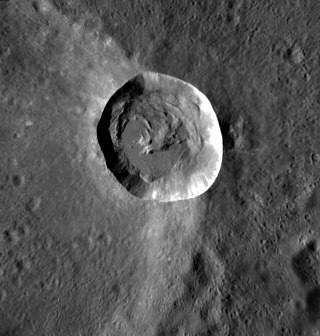
Mena is a crater in the Beethoven quadrangle on Mercury. Its name was adopted by the International Astronomical Union in 1976. Mena is named for the Spanish poet Juan de Mena, who lived from 1411 to 1456.
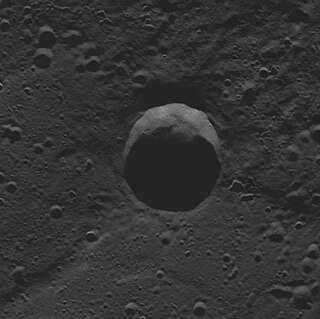
Carolan is a crater on Mercury. Its name was suggested by an Irishman, Fergal Donnelly, and two Americans, Joseph Brusseau and Deane Morrison, in a naming contest which was eventually adopted by the International Astronomical Union (IAU) on 2015. Carolan is named for the Irish composer and performer Turlough O'Carolan, who lived from 1670 to 1738 C.E. The craters Kulthum, Enheduanna, Karsh, and Rivera were also named as part of the contest.

Anguissola is a crater on Mercury. It has a diameter of 35.41 kilometres. Its name was adopted by the International Astronomical Union (IAU) on August 4, 2017. Anguissola is named for the Italian painter Sofonisba Anguissola.

Henri is a crater on Mercury. It has a diameter of 163.8 kilometres. Its name was adopted by the International Astronomical Union (IAU) on April 24, 2012. Henri is named for American painter Robert Henri.
